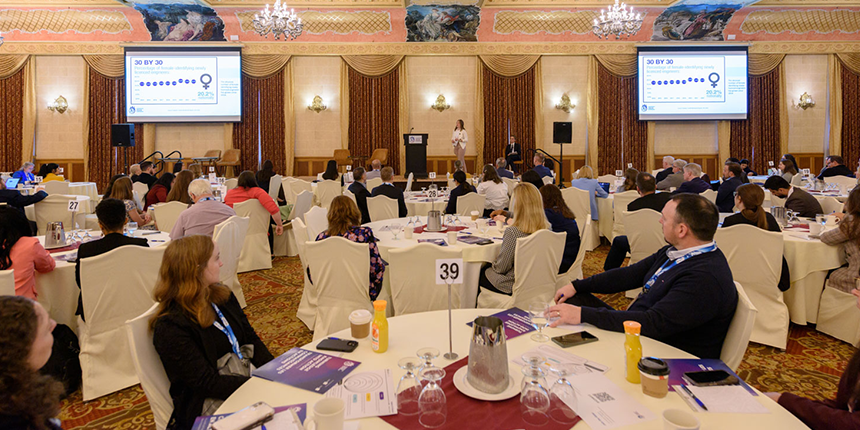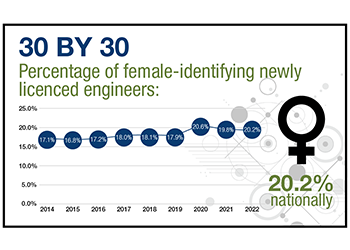

The 30 by 30 initiative—the engineering profession’s goal to see 30 per cent of newly licensed engineers be women by 2030—was launched nationally in 2014. Since its inception, the percentage of newly licensed engineers who are women has shown a positive, albeit modest trend, increasing to 20.2 per cent in 2022, from 17.1 per cent in 2014.
On behalf of Engineers Canada, Prairie Research Associates (PRA) Inc. conducted an environmental scan and formative evaluation of the first decade of 30 by 30 and presented the findings at this year’s 30 by 30 Conference on May 22, 2024, in Winnipeg, MB. The research suggests that despite this modest progress, 30 by 30 likely will not be achieved but that increasing gender equity in the profession remains a necessary goal.
30 by 30 at 10

Keynote speakers François Dumaine and Susanna Beaudin, both partners at PRA Inc., outlined what the 30 by 30 initiative has achieved in its first 10 years.
After the goal was set in 2014, new reporting metrics were established in 2015. Working groups and a strategic plan were established in 2019. 2021 saw the first annual 30 by 30 Conference take place.
Throughout these years, Engineers Canada has also produced a number of resources for the engineering community—such as guidelines, an equity, diversity, and inclusion training webinar, and a Managing Transitions guide for navigating parental leaves in engineering—all with the aim of advancing equity, diversity, and inclusion in engineering.
Yet 30 by 30 has also faced setbacks. The engineering profession does not exist in a vacuum and feels the effects of external trends. Dumaine and Beaudin pointed out, for example, that the COVID-19 pandemic significantly impacted women in the workplace worldwide in many industries, not just engineering. There is a general consensus that the pandemic exacerbated some already existing gender disparities. Progress in closing Canada’s gender wage gap was halted because of the pandemic; increased and unequal distribution of family care responsibilities worsened working conditions for women during the pandemic; and the pandemic directed skilled immigrant women towards unemployment, lower-skilled, or less stable employment.
On the other hand, the engineering profession is also evolving in a world that seems increasingly aware of social justice issues, and the formative evaluation of 30 by 30 found that the goal of making the engineering profession more inclusive remains highly relevant. And despite the modest progress in the number of newly licensed engineers who are women, Dumaine and Beaudin’s evaluation did find that 30 by 30 has helped to bring much needed focus, attention, and public dialogue to the issue of gender equity in engineering. It has helped to foster stronger relationships between various groups working on gender equity in engineering, allowing for greater unification around advocacy. The 30 by 30 brand has also added weight and credibility, making it easier for interest holders to get buy-in for their own programs and initiatives. And it has helped to generate research insights on the barriers that women continue to face in engineering.
Ongoing barriers to women’s participation in engineering
The theme of this year’s 30 by 30 Conference, Turning Knowledge Into Action for Gender Equity in Engineering, focused on taking what the engineering community has learned over the first decade of 30 by 30, and using it to refocus efforts and spur progress over the next six years as we approach 2030. The first decade of 30 by 30 saw a significant amount of research completed, both by Engineers Canada and others in the engineering ecosystem, that has elucidated a greater understanding of the barriers that still hinder gender equity in engineering.
These include barriers to recruitment that prevent girls and women pursuing STEM subjects in high school and post-secondary education, barriers to retention that can push women out of engineering, and barriers to career advancement, which prevent women from advancing within an engineering organization, faculty, or company.
In addition to these barriers to women’s participation in engineering education and the engineering workforce, Dumaine and Beaudin pointed out that because the 30 by 30 goal is inherently a licensure goal, barriers and pathways to engineering licensure are also important factors in evaluating 30 by 30. Research has suggested that career interruptions, such as family leave or changing jobs, can delay or deter engineers from obtaining their professional designation. A lack of support, such as limited regulator engagement and mentorship, adds to confusion around licensure and the feeling of being overwhelmed. And not all engineering graduates recognize the value of engineering licensure, particularly if their work does not involve public safety.
Recognizing the wide range of interest holders who exert influence over these barriers to gender equity in engineering—from education, to workplaces, to regulation—Dumaine and Beaudin’s keynote at the 30 by 30 Conference was followed by a workshop that asked conference attendees to reflect on their positions of power and influence within the engineering ecosystem. Led by Dr. Sarah Saska and Steph Rebello of Feminuity, a full-service equity, diversity, and inclusion consulting firm, the workshop asked attendees to identify what level of influence or control they can exert to challenge barriers to women’s participation in engineering, whether it be on a personal or interpersonal level, or whether they be team leaders, employers, members of educational institutions, or play a role in policy and governance of the profession.
The workshop encouraged conference attendees to consider how they can advance gender equity in engineering through their individual actions in their sphere of influence. Because everyone has a role to play in advancing gender equity in engineering.
The future of 30 by 30 and gender equity in engineering
Based on their environmental scan and their evaluation of the first 10 years of 30 by 30, Dumaine and Beaudin concluded by suggesting that there may be value in repositioning 30 by 30 to better leverage interest holders throughout the engineering ecosystem.
They pointed to the diverse array of interest holders who hold influence over the engineering ecosystem in Canada. While licensure remains an appropriate goal for 30 by 30, Dumaine and Beaudin suggested that it could be broadened by including other complementary goals “owned” by other interest holder groups and focused on other parts of the engineering ecosystem. In this way, repositioning 30 by 30 can renew commitment, clarify objectives and responsibilities, and create momentum and buy-in from a greater array of interest holders that have influence over engineering culture.
“This conference has paved the way for all of us to reflect deeply on … how we, in our unique positions in the ecosystem, hold levers to make change and can use those levers,” said Jeanette Southwood, Engineers Canada’s Vice President of Corporate Affairs and Strategic Partnerships, about power and influence in her closing remarks to the audience at the 30 by 30 Conference.
“I want everyone here today to know that Engineers Canada and the regulators stand committed to removing the systemic barriers, biases, and stereotypes that hinder the progress and limit the opportunities of women and other marginalized groups within engineering. It is all of our collective responsibility to dismantle these barriers and to foster an inclusive environment and create opportunities for all.”

“Looking ahead, let us not allow the insights gained during this conference to remain confined within these walls,” challenged Nancy Hill, Engineers Canada’s then-President as she closed the conference. “It is our duty to take these discussions, recommendations, and best practices back to our respective institutions, organisations, and communities.”
Engineers Canada plans on taking PRA’s research and recommendations to regroup and refocus its efforts and those of the 30 by 30 network over the next year.
“Everyone in the engineering ecosystem has a role to play in advancing gender equity in the profession, and over the next year as we refocus our 30 by 30 efforts, we’re going to increase the incorporation of a systems thinking approach into this work,” explains Kim Bouffard, Engineers Canada’s Manager of Belonging and Engagement. “We’re going to expand our 30 by 30 Champion program to continue to work strategically with engineering employers, higher education institutions, and the engineering regulators. And we’re going to be creating a new recruitment and retention strategy that will better incorporate both an intersectional lens and that systems thinking approach.”
In her closing remarks at the 30 by 30 Conference, Bouffard posed a question to the attendees, asking them if they were ready to change the culture of the engineering profession.
“Today, more than ever, we understand the problems, the barriers,” she said. “As a profession, engineers have the skills to address these problems, they are regarded as professional problem solvers. And we know that engineers are not afraid to put in the work. It’s not a question of if we can change, it’s are we ready? And are we willing to do what needs to be done? To prioritize changing this profession for the better, building on everything that we have learned and acting on it.
“I’d like to leave you with this. Throughout the conference I have heard many of you refer to the next generation multiple times today. Let’s not pass this problem onto the next generation when we can solve it, together, for them.”


